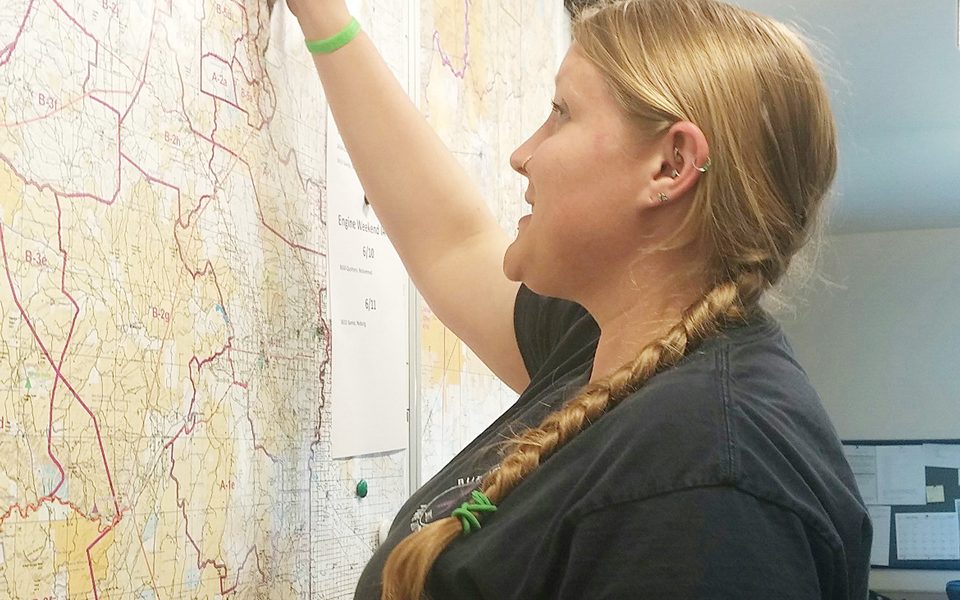
By Pat Caldwell
The Enterprise
VALE – Predicting a fire season is a delicate art grounded in science, history and a little bit of instinct, all of which can be swept away in a moment by the most powerful elusive factor – Mother Nature.
One chief intangible that haunts every fire season is the weather, including thunderstorms, said John Saltenberger a fire weather program manager at the Northwest Interagency Coordination Center in Portland. The center furnishes logistic and aviation support along with predictive services for state and federal agencies tackling wildfires in the region.
Saltenberger, a meteorologist, said volatile air in the atmosphere along with dry conditions are essential ingredients to make big fires.
“Instability in the atmosphere tends to lead to vertical motion. Most of the time the atmosphere moves horizontally. Fires tend to get larger when the atmosphere is unstable,” he said.
When the atmosphere is unstable – when it switches to a vertical flow instead of horizontal – it acts like a chimney flue, said Saltenberger. When the flue is open, the fire in the fireplace consumes more oxygen and grows. While the atmosphere can be unstable at any time, the condition usually affects fires in July and August, said Saltenberger.
He cautioned it is hard to forecast a fire season, but said 2017 is shaping up to be about average. That could change in an instant, however.
“I wish there was a secret formula we used but the truth is we try to look at the propensity for windy days, unstable days in the atmosphere and lightning but there are just not many objective tools available to calculate that kind of thing in advance,” said Saltenberger.
Saltenberger said Oregon and Washington average just a little over 4,000 fires a year but in 2016 the two states only recorded 2,416 blazes, the lowest number since 2000.
Locally, last year’s fire total was about average, John Dentinger, a fire operations supervisor for the Vale District of the BLM said. The Vale BLM tackled 25 blazes last year in the county and people sparked 14 of those. All 14 of those fires were unintentional.
Across the district, he said, the historical average is 20 fires a year of which 15 are triggered by people. The BLM Vale District includes 5.1 million acres stretched across Malheur, Baker, Umatilla, Union, Wallowa and Grant counties in Oregon and Asotin County in Washington.
Along with the weather, sources of ignition – either by lightning or by man – are another hard-to-predict element in a fire season, said Saltenberger.
“If fires occur from lightning or from humans when it is windy and dry or when it is unstable in the atmosphere, then we have more problems,” he said.
Saltenberger said the wet spring across the region will nudge the start of the fire season backward this summer.
Bob Narus, a fire manager for the Vale BLM District, agreed with Saltenberger, though he, too, cautioned conditions can change at a moment’s notice. Narus based his predication, in part, on the amount of moisture in sagebrush.
“We do monitoring of live fuel moisture in sagebrush and on average, if you compare this year to last year, most of our sites are about 60 percentage points higher than they were last year. They (sagebrush) have a lot more water in them,” said Narus.
Narus said the fire conditions will begin to evolve early next month.
“We are looking at the Fourth of July timeframe before things really start to dry out even in the lower elevations,” said Narus.
Perennial grasses in the area are also well stocked with moisture, said Narus.
“They (grasses) are not going to carry fire right now. They will hold that moisture for a while. So, once again, that will delay significant fires,” said Narus.
Another plus for firefighters is the amount of water that remains in the soil across the county.
“That helps, obviously. There is some moisture in the dirt if you go down deep enough because of the snow that melted and the rain we’ve been having,” said Narus.
Yet the soil around the county is already beginning to dry out, according to Stuart Reitz, a cropping systems agent for the Malheur County Extension office.
“I think it depends on where you are but if it is not irrigated it is getting drier and drier each day. Even with all the rain and if it continues to be warm the soil is drying out faster and faster,” said Reitz.
If a blaze does erupt locally, the Vale BLM District office can deploy a significant firefighting arsenal.
Narus said the Vale BLM firefighting corps consists of 125 people when it is at full strength. That includes a 20-person Hot Shot crew, a helicopter that transports initial attack firefighters and 20-person Snake River Valley crews.
Along with the crews, the BLM also deploys fire engines.
“We typically staff 17 engines. This year we probably are not going to staff that many because we don’t have qualified engine captains. So, we are hoping to staff around 13 or 14. I am still hopeful at the height of the fire season I will staff 17 engines,” said Narus.
Have a news tip? Contact reporter Pat Caldwell at 541-473-3377 or by email at [email protected].




